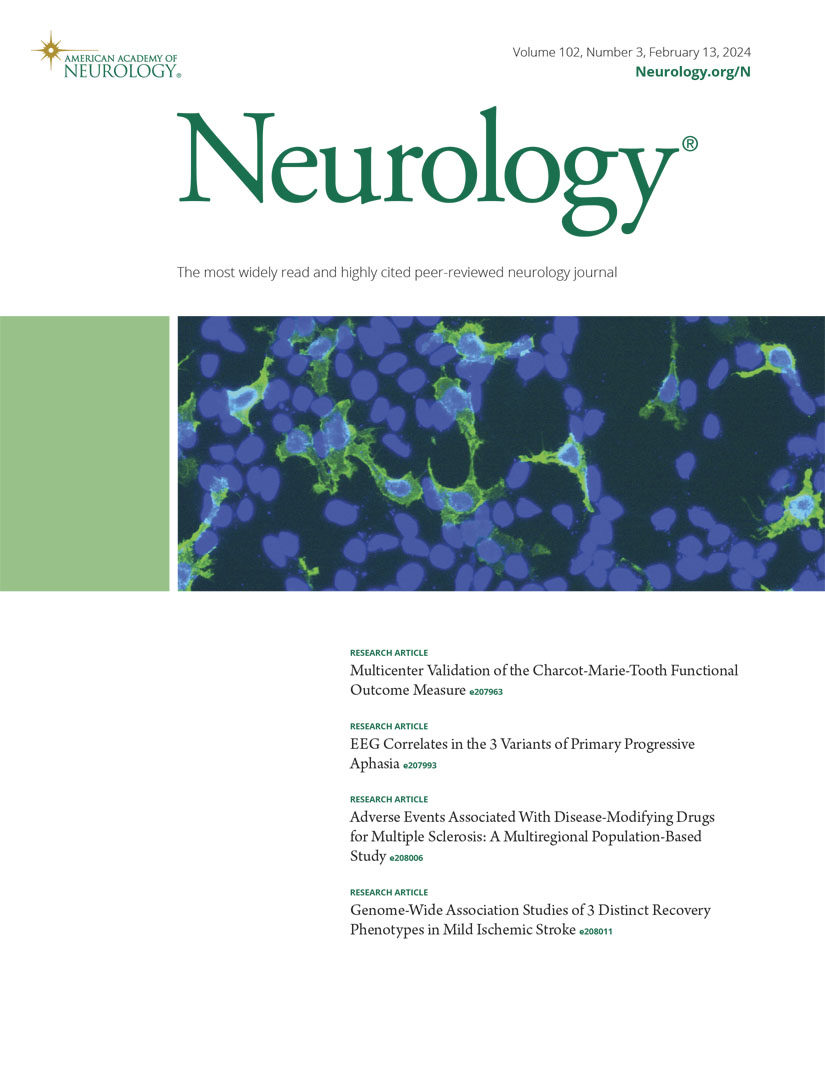基底动脉闭塞患者的非对比CT与CT灌注成像:ATTENTION和ATTENTION IA试验分析。
IF 7.7
1区 医学
Q1 CLINICAL NEUROLOGY
引用次数: 0
摘要
背景和目的急性CT灌注(CTP)或MRI在许多脑卒中中心没有广泛应用或常规进行。我们的目的是评估通过非对比CT (NCCT)选择进行血管内治疗(EVT)的急性基底动脉闭塞(BAO)患者与通过CTP选择的患者是否具有相似的结果。方法:这是对来自ATTENTION和ATTENTION IA试验的个体患者水平数据的事后分析。在估计发病24小时内出现BAO并通过NCCT选择EVT的患者与通过CTP选择的患者进行比较。主要观察指标为90天修正Rankin量表(mRS)评分0-3分。我们使用处理加权逆概率(IPTW)来解释混杂因素。结果550例BAO患者中,406例符合入选标准,其中NCCT入选EVT 274例(67.5%),CTP入选132例(32.5%)。年龄中位数(四分位间距,[IQR])为67(57-74)岁,70.7%为男性,基线NIH卒中量表评分中位数(IQR)为23(14-35),后循环急性卒中预后早期CT评分(pc-ASPECTS)中位数(IQR)为9(8-10)。NCCT组和CTP组的主要结局相似(mRS评分0-3:48.5% vs 45.5%, p = 0.56)。两组患者90天的功能独立性(mRS评分0-2:37.2% vs 33.3%, p = 0.44)、症状性颅内出血(4.5% vs 7.5%, p = 0.29)和90天死亡率(32.1% vs 34.9%, p = 0.83)相似。在IPTW分析中,90天mRS评分0-3无差异(优势比0.88 [95% CI 0.58-1.32], p = 0.53)。在24小时内接受EVT治疗的BAO患者中,与CT灌注相比,NCCT选择的患者在临床或安全结局方面没有差异。证据分类:本研究提供了IV级证据,证明在BAO患者中,选择使用NCCT进行EVT与选择使用CT灌注进行EVT具有相似的临床和安全性结果。临床试验注册信息:ClinicalTrials.gov NCT04751708。注意IA: ClinicalTrials.gov NCT05684172。本文章由计算机程序翻译,如有差异,请以英文原文为准。
Noncontrast CT vs CT Perfusion Imaging in Patients With Basilar Artery Occlusion: Analysis of the ATTENTION and ATTENTION IA Trials.
BACKGROUND AND OBJECTIVES
Acute CT perfusion (CTP) or MRI is not widely available or routinely performed across many stroke centers. We aimed to evaluate whether patients with acute basilar artery occlusion (BAO) who are selected by noncontrast CT (NCCT) for endovascular therapy (EVT) have similar outcomes compared with patients who are selected by CTP.
METHODS
This was a post hoc analysis of individual patient-level data from the ATTENTION and ATTENTION IA trials. Patients with BAO presenting within 24 hours of estimated onset and selected for EVT by NCCT were compared with those selected by CTP. The primary outcome was the 90-day modified Rankin Scale (mRS) score of 0-3. We used inverse probability of treatment weighting (IPTW) to account for confounders.
RESULTS
Of 550 patients with BAO, 406 met eligibility criteria, of whom 274 (67.5%) were selected for EVT by NCCT and 132 (32.5%) were selected by CTP. The median (interquartile range, [IQR]) age was 67 (57-74) years, 70.7% were male, the median (IQR) baseline NIH Stroke Scale score was 23 (14-35), and the median (IQR) posterior circulation Acute Stroke Prognosis Early CT Score (pc-ASPECTS) was 9 (8-10). The primary outcome was similar in both NCCT and CTP groups (mRS scores 0-3: 48.5% vs 45.5%, p = 0.56, respectively). Functional independence at 90 days (mRS scores 0-2: 37.2% vs 33.3%, p = 0.44, respectively), symptomatic intracranial hemorrhage (4.5% vs 7.5%, p = 0.29), and 90-day mortality (32.1% vs 34.9%, p = 0.83) were similar in both groups, respectively. In IPTW analysis, there was no difference in mRS scores 0-3 at 90 days (odds ratio 0.88 [95% CI 0.58-1.32], p = 0.53).
DISCUSSION
In patients with BAO treated with EVT up to the 24-hour time window, there was no difference in clinical or safety outcomes in patients selected by NCCT compared with CT perfusion.
CLASSIFICATION OF EVIDENCE
This study provides Class IV evidence that in patients with BAO, selection for EVT using NCCT yields similar clinical and safety outcomes compared with selection for EVT using CT perfusion.
TRIAL REGISTRATION INFORMATION
ATTENTION: ClinicalTrials.gov NCT04751708. ATTENTION IA: ClinicalTrials.gov NCT05684172.
求助全文
通过发布文献求助,成功后即可免费获取论文全文。
去求助
来源期刊

Neurology
医学-临床神经学
CiteScore
12.20
自引率
4.00%
发文量
1973
审稿时长
2-3 weeks
期刊介绍:
Neurology, the official journal of the American Academy of Neurology, aspires to be the premier peer-reviewed journal for clinical neurology research. Its mission is to publish exceptional peer-reviewed original research articles, editorials, and reviews to improve patient care, education, clinical research, and professionalism in neurology.
As the leading clinical neurology journal worldwide, Neurology targets physicians specializing in nervous system diseases and conditions. It aims to advance the field by presenting new basic and clinical research that influences neurological practice. The journal is a leading source of cutting-edge, peer-reviewed information for the neurology community worldwide. Editorial content includes Research, Clinical/Scientific Notes, Views, Historical Neurology, NeuroImages, Humanities, Letters, and position papers from the American Academy of Neurology. The online version is considered the definitive version, encompassing all available content.
Neurology is indexed in prestigious databases such as MEDLINE/PubMed, Embase, Scopus, Biological Abstracts®, PsycINFO®, Current Contents®, Web of Science®, CrossRef, and Google Scholar.
 求助内容:
求助内容: 应助结果提醒方式:
应助结果提醒方式:


